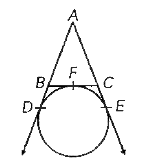A straight line parallel to the base BC of the triangle ABC intersects AB and AC at the points D and E respectively. If the area of the ΔABE be 36 sq. cm, then the area of the ΔACD is
18 sq. cm
36 sq. cm
18 cm
36 cm
The correct Answer is:B
To solve the problem, we will use the properties of similar triangles and the relationship between the areas of triangles formed by a line parallel to the base of a triangle.
1. Understand the Configuration:
We have triangle ABC with a line DE parallel to the base BC. Points D and E are on sides AB and AC respectively.
2. Identify the Given Information:
We are given that the area of triangle ABE is 36 sq. cm.
3. Use the Property of Parallel Lines:
Since DE is parallel to BC, triangles ABE and ACD are similar. This means that the ratios of their corresponding sides are equal.
4. Set Up the Ratios:
The ratio of the areas of two similar triangles is equal to the square of the ratio of their corresponding sides. Therefore, we can write:
Area of △ABEArea of △ABC=ADAB=AEAC
and
Area of △ACDArea of △ABC=CDCB=CECA
5. Establish the Relationship Between Areas:
Since the triangles ABE and ACD are formed by the same height from point A to line BC, the areas of triangles ABE and ACD will be equal if the segments AD and CD are equal. Therefore:
Area of △ABE=Area of △ACD
6. Calculate the Area of Triangle ACD:
Given that the area of triangle ABE is 36 sq. cm, we conclude:
Area of △ACD=36 sq. cm
Final Answer:
The area of triangle ACD is 36 sq. cm.
---
We have triangle ABC with a line DE parallel to the base BC. Points D and E are on sides AB and AC respectively.
We are given that the area of triangle ABE is 36 sq. cm.
Since DE is parallel to BC, triangles ABE and ACD are similar. This means that the ratios of their corresponding sides are equal.
The ratio of the areas of two similar triangles is equal to the square of the ratio of their corresponding sides. Therefore, we can write:
Area of △ABEArea of △ABC=ADAB=AEAC
and
Area of △ACDArea of △ABC=CDCB=CECA
Since the triangles ABE and ACD are formed by the same height from point A to line BC, the areas of triangles ABE and ACD will be equal if the segments AD and CD are equal. Therefore:
Area of △ABE=Area of △ACD
Given that the area of triangle ABE is 36 sq. cm, we conclude:
Area of △ACD=36 sq. cm
The area of triangle ACD is 36 sq. cm.
Topper's Solved these Questions
- MENSURATIONBook:KIRAN PUBLICATIONChapter:MENSURATIONExercise:TYPE - III
Explore 21 Videos
- MENSURATIONBook:KIRAN PUBLICATIONChapter:MENSURATIONExercise:TYPE - IV
Explore 169 Videos
- MENSURATIONBook:KIRAN PUBLICATIONChapter:MENSURATIONExercise:Test Yourself
Explore 28 Videos
- LCM AND HCF Book:KIRAN PUBLICATIONChapter:LCM AND HCF Exercise:Test Yourself
Explore 18 Videos
- MISCELLANEOUSBook:KIRAN PUBLICATIONChapter:MISCELLANEOUSExercise:TYPE-VI
Explore 15 Videos
Similar Questions
Knowledge Check
Inside a triangle ABC, a straight line parallel to BC intersects AB and AC at the point P and respectively. If AB=3PB, then PQ:BC is
Aa) 1:3Bb) 3:4Cc) 1:2Dd) 2:3ΔABC is an equilateral triangle and D and E are midpoints of AB and BC respectively. Then the area of ΔABC : the area of the trapezium ADEC is
A5:3B4:1C8:5D4:3In a triangle ABC, points P, Q and R are the mid-points of the sides AB, BC and CA respectively. If the area of the triangle ABC is 20 sq. units, find the area of the triangle PQR
A10 sq. unitsB5.3 sq. unitsC5 sq. unitsDNone of these
In ΔABC,DandE are the midpoint of AB and AC respectively. Find the ratio of the areas of ΔADEandΔABC.

View SolutionA triangle ABC (with usual notations) is a right angled isosceles triangle right angled at B. Let a line isdrawn passing through the centroid 'G' of the triangle and parallel to BC intersecting sides ABandAC at DandE respectively, if length of BC=9, then the area of quadrilateral ADGF (where F is the midpoint of AC) is
View SolutionThree medians AD, BE and CF of ΔABC intersect at G. The area of ΔABC is 36 sq. cm. Then the area of ΔCGE is
View SolutionArea of ΔABC=30cm2. D and E are the mid - points of BC and AB respectively. Find A(ΔBDE) :
View Solutionin ΔABC, a line parallel to side BC cuts the side AB and AC at points D and E respectively and also point D divide AB in the ratio of 1:4. If area of ΔABC is 200 cm2, then what is the area (in cm2) of quadrilateral DECB?
View Solution

